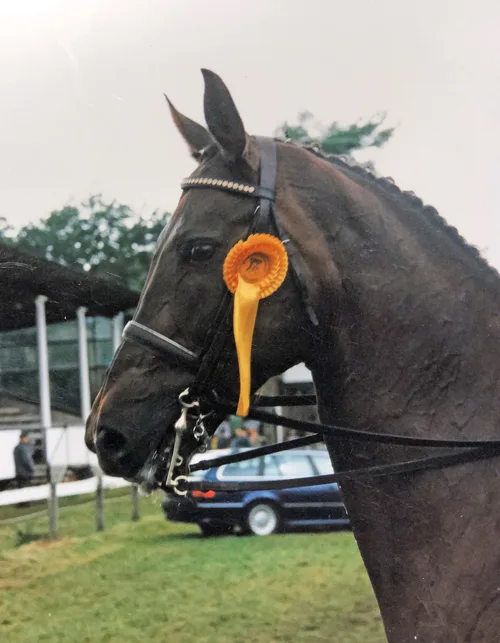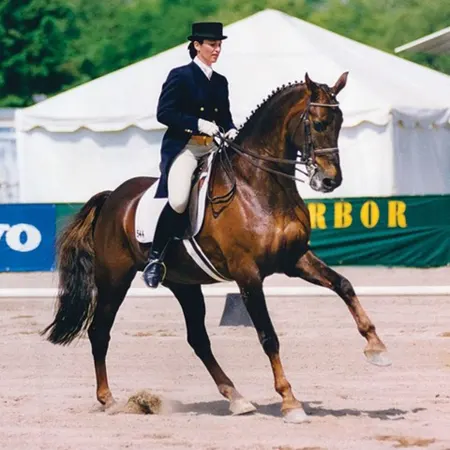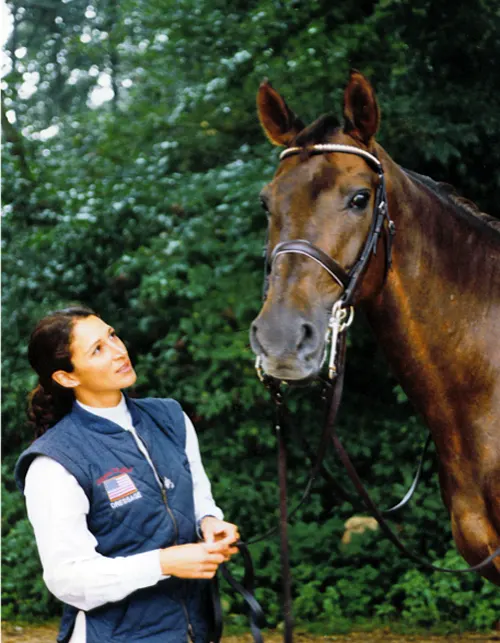Dear Rita,
In 2015, Dressage Today asked me to submit a short story about a difficult training problem I had encountered in my career and how I had solved it. I offered a story about my first successful FEI horse, Izotops, which I had written years earlier for a collection of short stories about horses.
The story was titled “Grace,” and because it was posted once on Facebook, it resurfaces now and again. I saw it on my feed this morning and thought to myself: I was soooo YOUNG when Izotops found me. I was so uneducated. I was so immature as a writer and a rider. This deserves a re-write in the year of hindsight.
Yeah, hindsight is always 2020.
I am even more humbled today by the mystical power of the horse than I was at that early point in my career. To those of us willing to listen to the deepest rivers of our universe, the teacher appears when we need him the most. Izotops was one of my first teachers.
Izotops was a Russian Warmblood of mysterious origins. He had been trained and competed in Italy before being sent to my newly established sales and training stable in Vechta, Germany. He was 10 years old, and the year was 1998.
I was working out of a lovely old farm owned by the Von Merveldt family in the middle of a magical forest called Gut Füchtel. In retrospect, I didn’t even know how little I knew about training Grand Prix horses. But I was in my early 30s, and my ears and eyes (all three of them) were open. I was learning fast, and I was determined.
One of the lessons that came to me early as a trainer was that of transience. I became good at letting horses touch my life and then letting them move on. Great horses came and went. Some came to be saved, healed or educated, and they moved on. They all came to train me, to teach me something, to show me my path. Some moved on to educate other people, and others moved on due to tragic events. But the flow of good horses through my life made me the person I am today.
I learned to treat this flow as a blessing. I could earn a living while learning my craft. I could help horses become good educators; I could become educated myself. But I had to get good at letting go. I had no choice. With my limited resources, it was my only opportunity to learn.
Izotops arrived at the beginning of this journey. He was a liver chestnut with no markings unless his ewe neck could be considered a distinguishing characteristic. He had hazel-colored eagle eyes that stared right past me even if I tried to stand in his line of sight. He had competed at CDIs and arrived with an FEI passport that had been stamped at several shows. But after trying to ride him a few times, I could find no other confirmation that he was even remotely trained.
In the first weeks that Izotops lived in the stable in that magical forest, he was oblivious to the world. It broke my heart. He would not acknowledge my presence in his life, even if I arrived at his stall with carrots and apples. He would not take sugar from my hand. He did not toss his head, nicker or even look toward his feed tub when the rest of the horses created the usual feeding-time din. He ate his meals after the aisle went quiet during the lunch break and after the lights went out at night.
ADVERTISEMENT
He was not aggressive. To the contrary, Izotops did not overtly react to any kind of stimulus. I would enter his box, put his halter on, pick out his feet, groom him, tack him up, and take him to the arena for his daily training without him interacting with me in any way. He was glassy-eyed and expressionless. He just did what he was told, slowly, with the minimum amount of effort. His focus stayed inward. He seemed to me to be in a heartbreaking state of trance.
Bizarrely, he stayed in this trance-like state even when frightened. I vividly remember him one day, piaffing like a zombie in a perfect robotic rhythm, with no tension and no expression—while cross-tied in the grooming box. A tractor had backfired behind him. He kept going long after the tractor had disappeared. I could only make him stop by freeing him and walking him out of the grooming stall.
Rita, if Izotops came to me today, I would know better what to do. I have tools now and resources. I have ulcer meds. I have one of the best veterinarians in the country. I know how to ride a little bit more than I did 20 years ago. But back then, I had such a light toolbox and such limited resources. To be honest, at that time, I was really only armed with good intentions and an inexplicable faith that I could make a difference in this horse’s life. And that was what I set out to do.
In the dressage arena, Izotops acted like your Uncle Benny on benzos. He was pleasant but not present. He trotted when told, but he would not change his tempo in trot. He cantered when told, but he would not change his tempo in canter. He would do a perfect flying change three strides after I asked. He was, simply put, completely out of it with delayed responses in real time.
Izotops performed this limited repertoire with me every day for three weeks without protest. BUT he refused to bow his head. I, Catherine Haddad, educated by two of the finest masters of dressage—Bodo Hangen and Willi Schultheis and well on my way to greatness—could not get Izotops on the bit.
I wanted to succeed with this horse—for his sake and for mine. I called on all the knowledge that I had in those three weeks to find a way to communicate with him. I sensed that there was darkness in his history, so I took my time. I rode diligently and correctly every day. I never used anything but a simple double bridle, normal spurs, a light whip and a balanced seat. I was patient. I asked; I did not demand.
I had been taught that any horse will submit to contact if the hand is sensitive, and the impulsion is focused from the back to the front. But I could not create enough impulsion (any really) to make Izotops connect to my hand for more than a fleeting moment. I refused to pull back against his mouth and his inverted neck. So we went round and round the arena in an ugly, upside-down unframe.
I had set the rules, and I would not break them. I would not use draw reins; I would not pull on him; I would not beat him. I would simply push him forward into a light contact until he submitted. The choice would be his. Or I would give up.
Eventually, I gave up. Izotops was clearly speaking a language I did not understand. I could not ride him. And because I had failed, I would have to send him back to where he came from. I remember this moment like it was yesterday. Failure has always haunted me and has always been my greatest catalyst to success.
When I gave up, I cantered him out of the arena straight onto the path that led into the forest. I was sad. He was a flat line. His head was up, his lower neck was pushed out, and he loped along as disinterested in the change of scenery as he was in all other things.

A transformed horse, Izotops proudly displays the ribbon from his first win in Germany. Catherine Haddad Staller Photo
Eventually, I slowed him to an ambling walk, and I spoke aloud to Izotops in English—my language. I told him I was sorry that I had failed him. I told him that I was just starting my career and that I could not afford to keep a horse just because I felt sorry for him. I needed room in my stable and in my life for the horses that would help me become a better rider. Couldn’t he do that so that he could stay with me? Was it too much to ask?
ADVERTISEMENT
I recall clearly my final plea to him on that day as I was contemplating the phone call I would have to make, “C’mon dude, give me a sign!”
Rita, I kid you not. This actually happened. In the next instant, Izotops launched himself into a powerful passage. Neck arched, back up, withers in my throat, he thrust himself over the ground like a kangaroo on crack cocaine. I frantically gathered my reins. A few breathless strides later, I asked for a canter depart, and he launched himself into perfectly balanced, jubilant one-tempis on the forest path. I laughed. My heart burst. I was delighted. I tried not to think. I just accepted his sign.
As Izotops turned the one-tempis into crow hops of ever-increasing proportions, I stayed on, which was probably the deciding factor in the formation of our future partnership. Breathless, elated, we turned back toward the stable that day in a state of true submission—we were on the bridle, and we had an agreement to work together.
Having come to the logical conclusion that Izotops was horribly ring sour (duh), I started his warm-up in the forest the next day and for many days afterward. If he had truly been ring sour, he let it go in those days, and he never looked back.
I touched my hands together and agreed to be soft with his mouth. He bowed his head and agreed to be forward. Our work became play, and I won my first three FEI-level tests in Germany later that year on Izotops. Those three wins were the first of 10 required to earn the German gold medal for dressage, an achievement that does not come easily in that country of top professionals.

Izotops and Catherine Haddad Staller flew to the USA to contend the Pan American qualifier at Bloomfield Open Hunt in Detroit in 1999. Photo Courtesy Of Catherine Haddad Staller
Izotops and I made a bid for the Pan American Games in 1999. We failed miserably. I kept going. Izotops educated a few riders and eventually moved on to a wonderful home with a great horsewoman in Colorado.
I earned my German gold medal in the international arena seven years later on Maximus JSS. The FEI World Equestrian Games and the FEI World Cup followed, but that’s another teacher and another story.
Today it would be easy to say that Izotops was simply ring sour when he arrived in my life, and that first little jaunt in the forest cured his ennui. But I believe we began a dance together that day because of a choice that he made, not something that got fixed in the physical world. Izotops made a choice for both of us, and we simply merged into a state of grace.
I’m Catherine Haddad Staller, and I’m sayin it like it is from Khiimori in Califon, New Jersey.
Training Tip of the Day: Never underestimate the mystical power of the horse.
Catherine Haddad Staller lived in Germany for almost 20 years and accumulated more than 120 top-10 placings and wins at Grand Prix during that time. In 2006, she was the team alternate for the FEI World Equestrian Games in Aachen, Germany, and the following year, she finished seventh at the FEI World Cup Finals in Las Vegas with Maximus JSS. She was reserve for the WEG once again in 2010 and rode in the Leipzig FEI World Cup Final (Germany) in 2011. She returned to the USA in 2012 and runs training facilities in New Jersey and Florida. She’s continued to compete internationally at Grand Prix and has also coached many riders at the FEI levels. An avid breeder, Staller’s foals have taken “best in class” honors at four Hanoverian foal shows in recent years. catherinehaddadstaller.com















